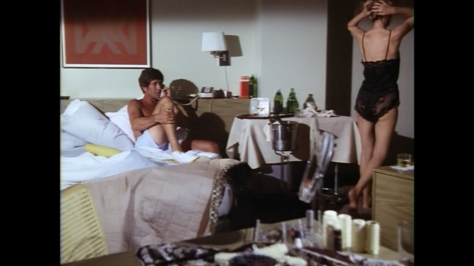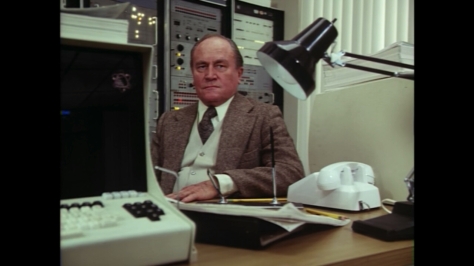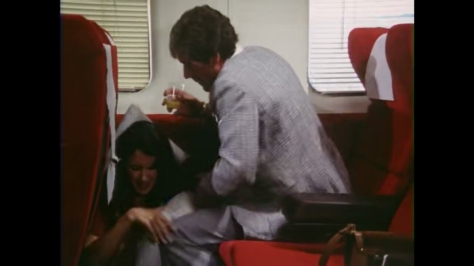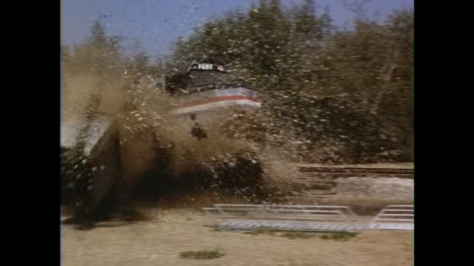So. It’s getting late and I don’t want to screw around. I don’t want “good” TV or “fine television” (blech), and I don’t want what everyone else wants, like GOT (this country, no question, is doomed). I want old timey stuff from my youth, with grown-up actors and actresses whom I recognize, in plots I can predict within 30 seconds.
I start rolling through those endless Netflix choices, going faster and faster because A) there’s nothing to watch, as always, and B) I hate how those blaring previews launch after you linger just one tiny second on a title. And I’m not even bothering with Hulu because there’s never anything old and schlocky there…before I remember I’ve been paying for Amazon Prime for 8 months now because I keep forgetting to cancel my free trial. Ah…relief: William Shatner and Yvette Mimieux and Lloyd Bridges and E.G. Marshall and Pat Hingle and Robert Fuller and Raymond Burr—all right there, perfectly preserved in the 1970s, waiting for me. The title, Disaster on the Coastliner, and that unparalleled cast of current and/or future has-beens, equaled instant made-for-TV movie satisfaction.
By Paul Mavis
The place and time is America, 1979, when Jimmy Carter was president (first clue it’s a disaster movie), and you rode Amtrak if every single other mode of transportation, including horse, catapult, and getting fired out of a cannon, was unavailable to you. As it happens, the airlines are on strike, so that means everyone criss-crossing from Frisco to L.A. and back again are trudging towards the depots—including the Vice President’s wife (uncredited and hot. Not Melania “hot,” but hot). Apparently, anytime a VIP like that travels with the plebs, the Secret Service sends an agent, such as surly, suspicious, coiled spring Al Mitchell (Lloyd Bridges), to the Trans Allied Railroad Company central control command station headquarters mission base computer nerve center, to make sure nothing happens to his high-value charge.
Click to watch Disaster on the Coastliner on Prime Video:
Well let me tell you something, amigo: it’s a damn good thing a guy like Al Mitchell is there, because those “eggheads” don’t know anything about running a railroad. Specifically: it’s all computer controlled; the humans are there merely for atmosphere and coffee consumption, and as Agent Al succinctly puts it, “to err is human, but to really foul things up, you need a computer.” Exactly, Al. Take the main switch-hitter, Roy Snyder (E.G. Marshall). He sneers at Al’s worries while making some snide anti-patriotic asides (yep, a Carter voter), smugly confident his motherboards and circuits will eliminate any chance that the Veep’s wife’s northbound train from Frisco, and the southbound coastliner from Hell-A—which conveniently occupy the same track—will crash headlong into each other.


Hoo boy what a mistake that technological hubris is…. You see, gargantuan tech “Victor Prescott” (Paul L. “Bluto” Smith) is really Jim Waterman, and he’s just jumbled Snyder’s wires into a giant bowl of spaghetti. Not only that, Bluto Waterman has quietly hijacked the northbound train and he’s ready to smash that baby right into Mrs. Veep’s iron horse unless he gets what he wants: an admission from Trans Allied Railroad Company’s rather hefty prez, Estes Hill (Raymond Burr), that TARC paid off rail inspector John Carlson (Lane Smith) to absolve the company of blame from a previous crash…a crash that killed Waterman’s wife and little baby.


RELATED | Read more 1970s film reviews
So…all Snyder has to do is call John Marsh (Pat Hingle), the engineer on the southbound train, and tell him to get the hell off the track, right? Wrong, chuckles. He’s way ahead of you. The thing is, Waterman has rerouted Marsh’s communication; he’s pretending he’s “Central Command,” and he’s telling Marsh all those bangings on the engineer security door? Well…they’re terrorists trying to take over the train. Ignore all lights, bells, whistles, and cops screaming out of helicopters, and keep chugging on, Casey Jones.


“Okey doke,” says dopey engineer John, and that leaves humanity with only one hope: William Shatner. He’s Stuart Peters, a con man who bamboozled his way onto the northbound train with the unwitting help of lovely Paula Harvey (Yvette Mimieux). Granted, she’s in a vulnerable state, being mighty peeved at her inconsiderate lover/player/dawg, Matt Leigh (Robert Fuller), who just so happens to be on the southbound train (oy vey). When all else fails…it’s up to Shatner, to Stop. That. Train.


RELATED | More Made-for-TV movie reviews
Despite the somewhat misleading title, I wouldn’t really call Disaster on the Coastliner a true “disaster” movie, even though certainly that’s the vibe you get from the set-up: a handful of, ahem, “name” stars, the threat of a deadly, catastrophic “event,” and large-scale action set pieces. Critically missing are two vital disaster genre ingredients: an actual calamity, and a large cast of seemingly incidental characters that we meet, get to know, and then root for as they’re cruelly picked off one by one during said calamity. Had Disaster on the Coastliner had the budget and time allotment (and God’s divine foresight) to slowly introduce us to Amtrak passengers such as Charo, Fernando Lamas, Jane Withers, Anson Williams, Sonny Bono, Arte Johnson, Karen Valentine, and Rip Taylor, before they were ground up into hamburger in a sensational train smash-up, then I think you could put it with other luminaries of the disaster genre that same year, such as Beyond the Poseidon Adventure, City on Fire, Avalanche Express, Meteor,and When Time Ran Out… (if 1974 was the apex of the golden age of the disaster movie, with The Towering Inferno, Earthquake, and Airport 1975…then surely 1979 was its nadir).


No, Disaster on the Coastliner has more to do with hijack actioners like The Taking of Pelham 1 2 3 or Juggernaut (and maybe a little of 1973 MTV Runaway!, about an out-of-control ski train). Maybe 1972’s Skyjacked!, as well (with the “psycho bent on revenge” angle), sans the big cast of potential victims. Regardless of its classification, Disaster on the Coastliner delivers just the right amount of small-screen suspense, action, and goofball late 70s TV moments that fans of these obscure MTVs crave.


That’s not surprising when you see who was behind the camera. Producer Frank von Zerneck, along with Robert Greenwald, had produced in just four years, one memorable, entertaining—or wonderfully awful—made-for-TV movie after another, including 21 Hours at Munich, Sharon: Portrait of a Mistress, Escape from Bogen County, Katie: Portrait of a Centerfold, Flatbed Annie & Sweetiepie: Lady Truckers, Anatomy of a Seduction, and Portrait of a Stripper (as well as one of the all-time MTV greats the following year, The Babysitter, with a returning William Shatner). British novelist and screenwriter David Ambrose had scripted several well-received U.K. TV dramas before hitting the television big-time with the international hit miniseries, A Man Called Intrepid, also in 1979 (he would go on to pen big screen efforts such as cult favorites The Final Countdown, Amityville 3-D, and D.A.R.Y.L.).


Always-interesting director Richard C. Sarafian began his career in television, helming episodes from a remarkable variety of series (everything from Bonanza and Dr. Kildare, to The Twilight Zone and Batman). He then moved into feature movies, where he eventually scored five cult action/suspense favs in a row: Fragment of Fear, Vanishing Point, Man in the Wilderness, Lolly-Madonna XXX, and The Man Who Loved Cat Dancing. The diminishing b.o. returns of the last three—after the unexpected smash success of Vanishing Point—put Sarafian into a cycle of alternating TV and big-screen assignments, such as in 1979, with Disaster on the Coastliner coming out that October, and Farrah Fawcett-Majors’ second feature, Sunburn, which a few months before sank like a stone in theaters all over the country.


An adept craftsman, Sarafian knows what he’s doing here; Disaster on the Coastliner’s opening credit sequence isn’t just a random montage—he’s playfully contrasting shots of the Amtrak trains and their serpentine tracks, with the equally convoluted circuit boards of the railroad computers…and in the process summing up the movie’s central premise. One of Sarafian’s main strengths is he moves his pictures along, and that’s a good thing in the case of Disaster on the Coastliner, because too close scrutiny of the frequently ridiculous storyline would hamper the fun.


If we stopped for more than a second to ponder all the plot holes and hanging threads that are present, we might let go of the general good cheer that improbably fills this slam-banger (of all the questions I had, the big one was: what did Bluto intend to do once he got the R.R. to confess?). It appears that everyone involved didn’t take this outing too seriously, from the actors that frequently find light, comedic moments in between the stunts, to the production crew (whose funny idea was it to have all the train car doors swoosh like Star Trek?), to the scripter (Ambrose frequently gets in amusing lines, like the two detectives pondering con man Shatner’s sudden heroics: “How do you explain a guy like that?” “You don’t…you drink to him.”).


True, some things you can’t ignore, such as the gandy dancers (all 10 of them…) supposedly single-handedly holding the curved track steady with their poles (make your own joke) while a mega-ton train comes screaming down on them at 60 miles an hour. But frankly, those are the kind of ridiculous improbabilities one actively looks for in these kinds of MTVs.


And synching up right along with that gleeful anticipation of incredulities is Disaster on the Coastliner’s cast. It’s impossible to watch outrageously-scowling and grousing Lloyd Bridges strutting around here, bandy-legged and ragin’, and not think of his iconic turn in Airplane! just a year later. I’m sure he wasn’t going for laughs…but it’s hard to contain the hilarity with a performance like this one (particularly noteworthy is his character’s willingness to impotently pull his service revolver…whether it’s on the coffee girl or the R.R. computer itself!). On the other hand, E.G. Marshall absolutely was shooting for laughs with his turn, and he succeeds completely, whether he’s staring in disbelief at Bridges’ line readings, or mocking his character’s intelligence, such as gleefully saying, “Chugga chugga chugga!” as he demonstrates to Bridges how the trains move on his computer board (my favorite: he spits out, “You still have a hella train derailment coming. And there’s nothing you can do about it,” which he says with an unashamed smile. Priceless.).



My wife, who usually avoids movies like Disaster on the Coastliner like the plague, happened to catch a few minutes now and then, chiefly when Robert Fuller was on (he’ll always be the original Emergency! “Dr. McDreamy” to her). But even she started to feel funny in her tummy—like food poisoning—whenever Fuller made his slimy presence known. It’s a comically repulsive turn, made all the more valuable because you can not tell if it was intentional or not (one of my new all-time favorite 70s MTV moments is when Fuller puts his bar chippie squeeze into “Emergency Fellatio Crash Position” when the passengers brace for a collision. How did the ABC censors miss that?).


As for Shatner…what can you say? He wears a cravat for most of the movie—that’s worth the price of admission alone. He has a tough assignment here: he has to work with this ridiculous material, and make it click as an action/adventure…while not looking (too) ridiculous himself. And he largely succeeds, by not taking himself seriously at all (something Yvette Mimimeux, sadly, does not—it’s like she’s performing in a straight drama, with no hint of the silliness going on around her. Tone deaf). When Yvette calls him a “thief,” he immediately counters, in a soft, ever-so-slightly-offended retort, “Don’t be harsh!” It’s hilarious, and indicative of his deft comedic touch.



Major kudos, as well, go to Shatner for his big brass f*cking balls—in his autobiography he called it, quite rightly, “stupidity”—for actually doing the stunts on the speeding trains. And let me tell you something: they’re not faked in any way; the train is going over 40 miles a hour; there are no safety wires or harnesses on him; and he was incredibly stupid to ever attempt this (only the bit with his character hanging off the end of a car, kicking gravel, looks like a stuntman). Now…if only someone had told the production company to really milk that train crash payoff for the audience (Jack Sessums’ model work is impeccable, as always…but the crack-up is over before you know it. Where’s the Peckinpah slo-mo repeat shots from multiple angles?).




Those action scenes in the last reel help pump up Disaster on the Coastliner considerably. Before them, it was a well-directed, moderately suspenseful small-screen hijacking thriller, with an almost frothy Hitchcockian undertone. But once Shatner starts crawling around on top of that train, and the chopper pilots execute these hairy aerial gags that they would never attempt today…well, Disaster on the Coastliner then becomes something quite unexpected: a genuinely thrilling small-screen actioner.




Can’t tell you how much this resonates and how much I enjoyed reading this. Amazon Prime Video has some great 70s and 80s made for TV movies.
LikeLiked by 2 people
Thanks for the note! Prime is a treasure trove of this kind of stuff–we love it!
LikeLiked by 1 person
Thank you for the kind words!
LikeLike